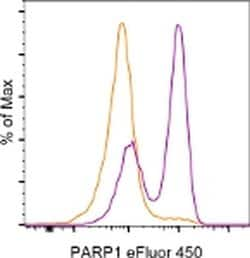Learn More
Invitrogen™ PARP1 (cleaved Asp214) Monoclonal Antibody (HLNC4), eFluor™ 450, eBioscience™
Mouse Monoclonal Antibody
Supplier: Invitrogen™ 48666842

Description
Description: This HLNC4 monoclonal antibody reacts with human poly (ADP-ribose) polymerase (PARP1). This ubiquitous 116 kDa nuclear enzyme is involved in DNA repair. During apoptosis, active caspases -3, -6 and -7 cleave PARP1 after Asp214, thereby inactivating PARP1 and generating two apoptotic fragments sized 85 kDa and 25 kDa. The HLNC4 antibody specifically recognizes the 85 kDa PARP1 fragment produced after cleavage and does not recognize the full-length 116 kDa protein. The following peptide was used as the immunogen: NH2-GVDEVAKKKSKKEKDC-COOH. Applications Reported: This HLNC4 antibody has been reported for use in intracellular staining followed by flow cytometric analysis. Applications Tested: This HLNC4 antibody has been pre-titrated and tested by intracellular staining and flow cytometric analysis of Jurkat cells using the Foxp3/Transcription Factor Staining Buffer Set (Product # 00-5523-00) and protocol. Please refer to BestProtocols®: Protocol B: One step protocol for (nuclear) intracellular proteins located under the Resources Tab online. This can be used at 5 μL (0.06 μg) per test. A test is defined as the amount (μg) of antibody that will stain a cell sample in a final volume of 100 μL. Cell number should be determined empirically but can range from 10^5 to 10^8 cells/test. eFluor® 450 is an alternative to Pacific Blue®. eFluor® 450 emits at 445 nm and is excited with the Violet laser (405 nm). Please make sure that your instrumen...
Poly ADP-Ribose Polymerase (PARP) uses nicotinamide adenine dinucleotide (oxidized form) NAD as a substrate to catalyse the transfer of ADP-ribose to a variety of nuclear protein acceptors. Proteolysis of PARP to its stable 85kDa fragment is an early marker of programmed cell death (apoptosis) and is mediated by the caspase CPP32 protein. Cleavage occurs between Adp216 and Gly217, a site in PARP conserved across species.
Specifications
| PARP1 (cleaved Asp214) | |
| Monoclonal | |
| 5 μL/Test | |
| PBS with BSA and 0.09% sodium azide; pH 7.2 | |
| P09874 | |
| PARP1 | |
| Affinity chromatography | |
| RUO | |
| 142 | |
| 4°C, store in dark, DO NOT FREEZE! | |
| Liquid |
| Flow Cytometry | |
| HLNC4 | |
| eFluor 450 | |
| PARP1 | |
| 5830444G22Rik; ADP-ribosyltransferase (NAD+; ADP-ribosyltransferase (NAD+) poly (ADP-ribose) polymerase); ADP-ribosyltransferase (NAD+, poly (ADP-ribose) polymerase) 1; ADP-ribosyltransferase (NAD+; poly (ADP-ribose) polymerase); ADP-ribosyltransferase (NAD+; poly (ADP-ribose) polymerase) 1; ADP-ribosyltransferase 1; ADP-ribosyltransferase diphtheria toxin-like 1; ADP-ribosyltransferase NAD(+); Adprp; Adprt; ADPRT 1; ADPRT1; AI893648; ARTD1; C80510; DNA ADP-ribosyltransferase PARP1; msPARP; NAD(+) ADP-ribosyltransferase 1; pADPRT-1; PARP; Parp1; PARP-1; poly (ADP-ribose) polymerase 1; poly (ADP-ribose) polymerase family, member 1; poly (ADP-ribose) polymerase); poly [ADP-ribose] polymerase 1; poly(ADP-ribose) polymerase; poly(ADP-ribose) polymerase 1; poly(ADP-ribose) polymerase PARP-1; poly(ADP-ribose) synthetase; poly(ADP-ribosyl)transferase; poly[ADP-ribose] synthase 1; poly[ADP-ribose] synthetase 1; PPOL; Protein poly-ADP-ribosyltransferase PARP1; sPARP-1; synthetase fragment (AA 67); Unknown (protein for IMAGE:8023736); unnamed protein product | |
| Mouse | |
| 100 Tests | |
| Primary | |
| Human | |
| Antibody | |
| IgG1 κ |
The Fisher Scientific Encompass Program offers items which are not part of our distribution portfolio. These products typically do not have pictures or detailed descriptions. However, we are committed to improving your shopping experience. Please use the form below to provide feedback related to the content on this product.
